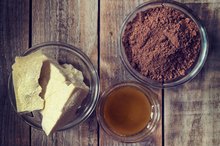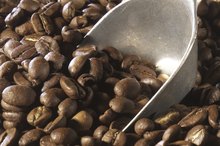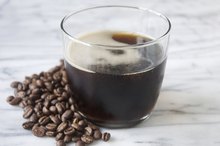FDA Regulations for Caffeine
Caffeine is widely used, found in drinks such as coffee, tea and sodas, as well as a variety of foods and drugs. How the U.S. Food and Drug Administration (FDA) treats a product with caffeine in it depends on whether or not the product is categorized as a food or a drug. The laws surrounding caffeine and the FDA's regulation of caffeine products is complicated.
Caffeine in Food
Caffeine, when categorized as a food, is fit for human consumption and is generally recognized as safe. Under 21 Code of Federal Regulations section 182.1180, the federal government states that caffeine is generally recognized as safe as used in cola or soft-drink products and when it is used in accordance with proper manufacturing processes. Safe substances do not require any FDA approval as long as they fall within the safe levels dictated by the statute.
Safe Levels
Can Excess Caffeine Cause Rashes?
Learn More
The federal regulations governing the use of caffeine also establish a "tolerance" that applies when manufacturers want to add caffeine to a product. In fact, 21 Code of Federal Regulations section 182.1180(b) states that caffeine's tolerance is .02 percent. This means that any product manufactured with caffeine must have .02 percent or less of the substance in the product to be considered safe. For example, a 12 oz drink can have 68 mg of caffeine and still meet the .02 percent limit.
- The federal regulations governing the use of caffeine also establish a "tolerance" that applies when manufacturers want to add caffeine to a product.
- This means that any product manufactured with caffeine must have .02 percent or less of the substance in the product to be considered safe.
Caffeine as a Drug
When caffeine is used as a drug, such as in a diet pill or other product, the FDA has a strict approval process through which a manufacturer must proceed before the drug is approved for sale in the United States. The FDA approval process requires the manufacturer to show that the drug is fit for human consumption. When approved as a drug, the manufacturer must include labeling information that reveals exactly how much caffeine is in the product.
Dietary Supplements
Possible Side Effects of Metabolife Ultra
Learn More
Federal law also allows manufacturers to produce "dietary supplements" that may contain caffeine. The FDA is responsible for overseeing dietary supplements, but manufacturers do not need to get FDA approval for such products. Supplement manufacturers merely have to ensure that their products are not harmful before they can sell them. Because:
- the FDA allows manufacturers to include "botanicals," or plants
- in supplements,
- many plants naturally contain caffeine
- many dietary supplements also contain caffeine even if it is not included on the label
- according to Science Daily [2](https://www.sciencedaily.com/releases/2009/04/090419200847.htm 'inline-reference::Science Daily: Analyzing Caffeine In Selected Dietary Supplements; Apr
24, 2009').
- Federal law also allows manufacturers to produce "dietary supplements" that may contain caffeine.
- The FDA is responsible for overseeing dietary supplements, but manufacturers do not need to get FDA approval for such products.
Related Articles
References
- CNN Heatlh: FDA Calls 7 Caffeine-Alcohol Drinks Unsafe
- Science Daily: Analyzing Caffeine In Selected Dietary Supplements; Apr. 24, 2009
- Legal Electronic Document Archive: Reconsidering Caffeine: An Awake and Alert New Look at America’s Most Commonly Consumed Drug, David M. Mrazik, April 27th, 2004
- Meredith SE, Juliano LM, Hughes JR, Griffiths RR. Caffeine Use Disorder: A Comprehensive Review and Research Agenda. J Caffeine Res. 2013;3(3):114-130. doi:10.1089/jcr.2013.0016
- Richards G, Smith AP. A Review of Energy Drinks and Mental Health, with a Focus on Stress, Anxiety, and Depression. J Caffeine Res. 2016;6(2):49-63. doi:10.1089/jcr.2015.0033
- Brunyé TT, Mahoney CR, Rapp DN, Ditman T, Taylor HA. Caffeine enhances real-world language processing: evidence from a proofreading task. J Exp Psychol Appl. 2012;18(1):95-108. doi:10.1037/a0025851
- Koppelstaetter F, Poeppel TD, Siedentopf CM, et al. Caffeine and cognition in functional magnetic resonance imaging. J Alzheimers Dis. 2010;20 Suppl 1:S71-84. doi:10.3233/JAD-2010-1417
- Harrell PT, Juliano LM. Caffeine expectancies influence the subjective and behavioral effects of caffeine. Psychopharmacology (Berl). 2009;207(2):335-42. doi:10.1007/s00213-009-1658-5
- Lucas M, O'reilly EJ, Pan A, et al. Coffee, caffeine, and risk of completed suicide: results from three prospective cohorts of American adults. World J Biol Psychiatry. 2014;15(5):377-86. doi:10.3109/15622975.2013.795243
- Abdel-Hady H, Nasef N, Shabaan AE, Nour I. Caffeine therapy in preterm infants. World J Clin Pediatr. 2015;4(4):81-93. doi:10.5409/wjcp.v4.i4.81
- American Psychiatric Association. Diagnostic and Statistical Manual of Mental Disorders. 5th edition. Washington DC; 2013.
- Turnbull D, Rodricks JV, Mariano GF, Chowdhury F. Caffeine and cardiovascular health. Regul Toxicol Pharmacol. 2017;89:165-185. doi:10.1016/j.yrtph.2017.07.025
- Centers for Disease Control and Prevention. Alcohol and Caffeine. Updated October 23, 2018.
- Alsunni AA. Energy Drink Consumption: Beneficial and Adverse Health Effects. Int J Health Sci (Qassim). 2015;9(4):468-474.
- Lyngsø J, Ramlau-Hansen CH, Bay B, Ingerslev HJ, Hulman A, Kesmodel US. Association between coffee or caffeine consumption and fecundity and fertility: a systematic review and dose-response meta-analysis. Clin Epidemiol. 2017;9:699-719. doi:10.2147/CLEP.S146496
- U.S. Food and Drug Administration. Pure and Highly Concentrated Caffeine. Updated September 21, 2018.
- National Institute on Drug Abuse. Drugs, Brains, and Behavior: The Science of Addiction. Updated July 2018.
Writer Bio
Roger Thorne is an attorney who began freelance writing in 2003. He has written for publications ranging from "MotorHome" magazine to "Cruising World." Thorne specializes in writing for law firms, Web sites, and professionals. He has a Juris Doctor from the University of Kansas.









